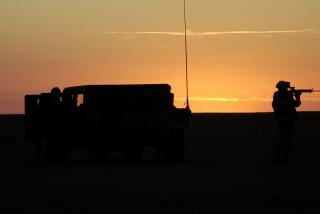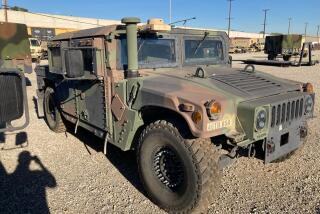Soldiers Get Extra Layer of Defense
- Share via
CAMP VICTORY, Iraq — When Eric Giordano offers to show his war wounds, there’s no need to blush.
Shrapnel scars from a February bombing and a deep gouge from a blast in May are on the Army specialist’s second skin, the armored Humvee that carried him whole and unscathed through both explosions.
For the record:
12:00 a.m. July 31, 2005 For The Record
Los Angeles Times Sunday July 31, 2005 Home Edition Main News Part A Page 2 National Desk 0 inches; 31 words Type of Material: Correction
Humvees in Iraq -- An article in Friday’s Section A about armored Humvees in Iraq misstated the total number of Humvees deployed in that country as 6,000. There are about 24,000.
“The armor plating took most of the hit,” the 22-year-old military policeman from Staten Island, N.Y., says with an appreciative pat on the vehicle’s disfigured hood. “The window next to my head shattered but the inside pane held up. I have that in my room now.”
The Humvee’s gunner, Pvt. Matthew Michels of Buffalo, N.Y., was nicked on the chin by a piece of the Humvee’s .50-caliber machine gun when the force of the explosion blasted it to pieces. He shudders to think what would have happened if he’d been standing instead of hunkered down in the armored collar behind the gun mount.
More than two years into the Iraq conflict, most of the light utility vehicles securing supply routes and escorting convoys are now armored to withstand the kind of roadside blasts that killed at least 400 soldiers in Humvees before the Pentagon ordered the improved protection.
Two-thirds of the nearly 6,000 Humvees deployed across Iraq are factory-armored, coming off an Ohio assembly line with an extra 2,000 pounds of protective plating and bulletproof windows, and the Iraq mission has priority for getting new ones. With some members of Congress complaining that the work has been too slow, about 300 more vehicles are being upgraded each month by private contractors at bases in Iraq and Kuwait.
U.S. troops using Humvees and other vehicles are still not out of danger. On the highways, streets and alleys that are the battlefields of this conflict, soldiers traveling in the vehicles never intended for front-line combat now face suicide drivers and more powerful bombs capable of penetrating new defenses.
This week alone, seven American troops have been killed in roadside bombings in Baghdad and Samarra.
Almost every day, a suicide bomber or insurgents with improvised explosive devices, or IEDs, have attacked Humvees of the 108th Military Police Company to which Giordano, Michels and about 180 others belong.
“We’ve got a clever enemy that is always trying to find a nick in our armor,” says Allen Blanchette, the company’s 1st sergeant. “We react to what they do and they react to what we do.”
Bracing for the insurgents’ next innovation makes for nerve-racking duty.
On a recent Saturday afternoon with a 110-degree breeze flowing in from the gun turret, Sgt. Adam Cook rides shotgun with a newly composed patrol team, combing the highways around the Abu Ghraib prison for insurgents and their deadly concoctions. He spots a white sedan at three different onramps within an hour, fueling his suspicion that it is the same car and is stalking the convoy.
“Let’s open it up,” he yells to the driver, Sgt. Angel Alicea of Puerto Rico. Alicea hits the gas and the Hummer’s eight cylinders heave the unit into action. As the soldiers approach the onramp and the face of the car’s driver comes into view, Cook makes a fist in front of his side window. The driver brakes, conforming to the battlefield etiquette of stopping to show a passing convoy that he poses no hazard. The team concludes that he wasn’t stalking them and drives on.
“The sign comes from the Iraqis,” Cook, of Portland, Ore., says of the fist signal. “You see them using it, like when they want you to stop talking.”
Suicide bombers have become the unit’s biggest fear. Cars and trucks packed with explosives have ripped open even Bradley fighting vehicles, which have much heavier armor. The Humvees, which rack up about 4,000 miles a month each, are always on the road, making them ready targets for insurgents.
The vehicle, which looks like a boxy version of the jeep, has four seats and the gunner’s sling and a roomy trunk in the rear. Although now armored, the Humvees were never meant to be fighting vehicles like tanks, but rather were designed to transport goods and soldiers behind the front lines.
From inside the Humvee, everything on the road portends danger: The empty banana box by the guardrail could be covering a bomb. Wasn’t that curl of tire tread closer to the asphalt on the last passing? The driver of the blue pickup carrying canisters of cooking fuel could be scoping out a promising target.
“Sometimes they use kids as spotters,” Cook says as the Humvee speeds past a boy of about 6 who has clambered onto the roadside, fingers tapping his mouth in a gesture of hunger.
Spc. Joseph Wolfe, the gunner, whose knees are about all his patrol mates see of him, rides in a sling in the turret, his arms cradling the gun mount, as the Humvee turns off the highway. He and Cook keep each other abreast of what could be trouble.
“Are you keeping an eye on the guy with the pink bag?” Cook asks through his radio headset. All eyes have been trained on the young bearded man since he and a woman cloaked in a black abaya emerged from an alley, the man lugging a heavy pink and black duffle bag. The man glares at Cook’s brandished fist but halts on the sidewalk, motioning to the woman to do likewise.
What seems like paranoia to an outsider may be vigilance born of experience. The radio chat among the convoy crew members, the only way to communicate over the thunderous grinding of the engine, may be picked up by insurgent lookouts.
“We were talking the other day about how anything could be in these buildings,” Cook recalled, gesturing to a cluster of flat-roofed houses separated from the road by vegetable plots. “Right after I said that, all the wives and daughters and whatever, all the females, came out on the roof, like they were trying to show us who was in there.”
Cook, Alicea and Wolfe returned to Iraq at the start of this year for a second tour of duty, after a stint in the north that began with the March 2003 invasion. Veterans of the earlier era of soft-skinned Humvees, the crew members count their blessings and credit the armored version with giving them more confidence that they will survive.
“It’s uncomfortable and it’s noisy, but it’s never failed to do what I want it to do,” Cook says of the Hummer he’ll be riding in 12 hours a day for the rest of the year. “I know they can take a licking and you’ll still live.”
An armored Humvee he once was riding in protected its crew from the explosion of a 1,500-pound bomb. There were cuts and scrapes and palpitations, but the newly fitted coat of armor saved their lives.
The close calls and the shared tension have a bonding effect on the troops, not just with one another but with the Humvee they’ve been assigned.
“In most cases, we try to keep a team together and only rotate for maintenance or if there are battle losses,” says Chief Warrant Officer Craig Schuster, with the 18th Military Police Brigade, which protects convoys and guards prisoners with its 648 Humvees. “You develop a relationship with your vehicle. I put mud flaps on the back of mine and mounted a tool box. You can also put in more comfortable seats.”
Despite the good-luck-charm feeling troops say they have about their Hummers, few can fathom the appeal of the civilian version plying stateside roadways and filling garages.
They shake their heads at the thought of dropping $60,000 on a car that gets 12 miles a gallon. Two sleek Hummers owned by civilian contractors can be seen around Camp Victory, their red metallic and polished black exteriors clashing with the Army green and khaki colors of the military models.
“After about 12 years of riding around in one, I’m not sure I’d want to buy one,” Cook says.
Sgt. Christine “Ski” Skelonc, Giordano and Michels’ unit commander, has not seen the interior of the sleek civvies but speculates that they are packed with gadgets.
“I’d like to ride in one someday,” the 29-year-old Minnesotan says as she surveys her own battered Hummer. “I’m sure they’re a lot more comfortable than this one.”
Humvees, a name derived from the initials HMMWV, for High-Mobility Multipurpose Wheeled Vehicle, became frequent targets of insurgents early in the Iraq conflict because they are perceived as the Achilles’ heel of Army vehicles. Troops welded improvised armor onto the vehicles and complained about the lack of protection.
“Early on, when the vehicles weren’t so well protected, we were taking more casualties,” Schuster says, though he, like other coalition sources, has no statistics. “Now some of them are so well armored that even when they are hit by an IED everybody walks away.”
Of the 70 or so daily attacks on coalition troops, most are directed at convoys, and most convoys are escorted by MPs in Humvees.
The 108th Company has lost two people since February; both were outside their vehicles. Its predecessors saw eight Humvee patrollers killed in action, most in unarmored Humvees.
Now the convoy escort and patrol units are being augmented by a heavier armored vehicle, the M1117 ASV, or armored security vehicle. The 18th MP Brigade has about 45 in its fleet and more are on the way, Schuster says.
The ASV costs $800,000, before pricey satellite communications and state-of-the-art weapons are added. The factory- armored Humvee, called the M1114, runs $146,840 without equipment.
But bigger isn’t always better. The two vehicles have equal speed, but the ASV is so uncomfortable that crews take more frequent breaks to stretch, which exposes them to danger.
Some troops complain that the ASV’s more sophisticated electronic controls make repairs more complicated.
Humvee drivers also have mixed feelings about their vehicles versus the ASV.
“It’s just not maneuverable to have tanks running up and down the streets,” Schuster says. “The Humvee is more mobile.”
More to Read
Sign up for Essential California
The most important California stories and recommendations in your inbox every morning.
You may occasionally receive promotional content from the Los Angeles Times.














